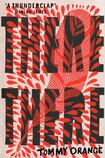
Towards the beginning of There There, Tommy Orange’s powerful debut, a character called Dene Oxendene appeals for funding for a film project. “[W]hat I want to do, is to document Indian stories in Oakland,” he proposes. “I want to put a camera in front of them, […][L]et them tell their stories […]with no direction or manipulation or agenda. […]I want to bring something new to the vision of the Native experience as it’s seen on the screen.”
As Dene delivers his pitch, it is easy to imagine that Orange, too, is laying out a manifesto for the book. “What we’ve seen is […]stereotypes” he tells us, whereas he wishes to depict what we haven’t seen – the “urban Indian story”, the “whole picture”.
Orange had received funding for a similar project, from the Oakland Cultural Arts Fund – a project that “never came to fruition, except for in fiction”. It’s easy to see Dene as an author surrogate: Orange’s representative in the text.
There There is named after the Radiohead song, as well as Gertrude Stein’s observation about Oakland: “There is no There There.” It was recently longlisted for the International Dublin Literary Award, having received the most nominations of all the books on the shortlist. Widely lauded for its depiction of Native Americans, it comprises disparate narratives.
As a portrayal of native people, it is the most nuanced and illuminating I have seen.
There is Edwin Black, a young man with food and internet addictions, searching for his estranged father, along with his native identity. There are Opal and Jacquie, sisters who, as children, live on Alcatraz as part of the Native Occupation of the island. (This occupation took place between 1969 and 1971, as a protest to call attention to Indian oppression. Marked as a success of activism by many, here, the appeal to “start from inside the cell, which is where [Indian people] are now”, and “work our way out from the inside with a spoon”, appears decidedly futile and tragic). Cut to the story of Bill Davis, a disgruntled janitor who was once “dishonourably discharged” from the army, or Daniel Gonzales, a vulnerable young man who prints a gun from a 3-D printer, or Octavio Gomez a drug dealer who plans to steal money from a powwow (a native ceremony).
The characters are wide-ranging, but all have some connection to Oakland and the native experience. These are stories of yearning and captivity, of neglect and repression – stories that search for redemption, all the while threatening regression. As a portrayal of native people, it is the most nuanced and illuminating I have seen.
But tempting as it is to read the book as Dene’s (and also Orange’s) filmic project come to pass, it is also prudent to remember that there is no film here – we never, in effect, see “what we haven’t seen”. Instead of Dene’s promise to make something “with no direction or manipulation or agenda”, we get curated, authored, pieces. The seemingly disparate tales are in fact quite cohesive. Just as we become rapt in one, we catch the gleam of another, and are thus led towards the book’s revealing ending. (I long to tell you what happens in this rapturous final scene at the powwow, but suffice to say you should go see the sorry spectacle for yourself.)
Indian head test
Most notably, this project is never rendered on screen. In fact, the screen is a dangerous place for an Indian. The first sentence of the book describes an “Indian head test pattern” that, up until the late 1970s, appeared on American TVs after all the shows ran out. It was “just above the bull’s-eye, like all you’d need to do was nod up in agreement to set the sights on the target”.
“Turned-off TVs” appear at various points throughout the text, as does the reminder of the damaging portrayals of Indians on screen throughout history. At one point, a character encounters his face “in the dark reflection” of a TV and notes: “It was the first time I saw it. My own face, the way everyone else saw it.” Orange seems wary of capturing the Indian experience as “everyone else” sees it. A camera, and it is notable that Dene’s has a “pistol grip”, might have a dangerous and exploitative power.
But displaying these stories on the page is not an easy out. What’s ingenious about this book – a book about the Indian experience – is that it seems wary of capturing the Indian experience at all. Indians who “don’t look like what they look like”, “Indians dressed up as Indians”, the book sits in its own uncertainty: grabs at the truth and misses. Which is perhaps just what it means to do: gesture towards the notion that people cannot be captured. And that’s as powerful a manifesto as any.











